
You can quickly master easy piano songs like “Lean on Me” and “Let It Be” by starting with their simple chords and melodies. Break these songs into smaller sections, and use online tutorials and simplified sheet music to guide your practice. Focus on getting comfortable with the basics before you add any complexity. Practicing with a metronome will help you keep a steady rhythm, and don’t forget to practice hands separately before bringing them together. This approach enhances your motivation and speeds up your learning process. As you progress, you’ll find more nuances and techniques that will make your piano playing sound even better.
- Choosing Your First Song
- Simplified Arrangements Explained
- Learning "Fur Elise" Quickly
- Mastering "Lean on Me"
- Tips for "Twinkle Twinkle"
- Playing "Happy Birthday" Flawlessly
- "Clair De Lune" for Beginners
- Navigating Sheet Music Sources
- Practice Techniques That Work
- Progressing Beyond Basic Songs
- Frequently Asked Questions
- Conclusion
Choosing Your First Song
When selecting your first piano song, it’s best to start with something simple and enjoyable, like “Lean on Me” or “Let It Be.” These songs not only offer straightforward chord progressions and memorable melodies but also boost your motivation to keep practicing.
They’re among the easiest pop piano songs and perfect examples of easy songs to learn on piano. You’ll find these to be good songs to play on the piano as they’ll help you quickly grasp basic chords and rhythmic patterns.
You should also consider choosing songs in keys like C major or G major. These keys feature simpler chords that are less intimidating for beginners. Additionally, breaking the song into manageable sections can drastically improve your learning process. It allows you to focus on mastering one part at a time, gradually building up your confidence and skills.
Lastly, don’t forget to use resources like online tutorials and beginner-friendly sheet music. These tools provide visual aids and step-by-step instructions that make learning your selected songs more straightforward and enjoyable.
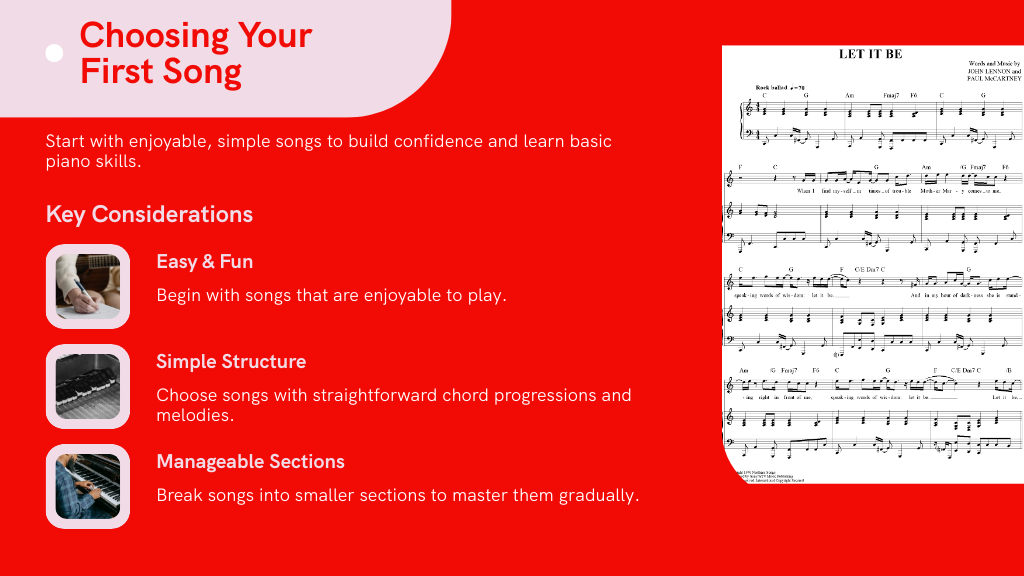
With these strategies, you’ll not only enjoy your practice sessions more but also fast-track your piano-playing journey.
Simplified Arrangements Explained
As you start your piano journey, simplified arrangements are your best friends.

They’ll help you understand sheet music more easily, and we’ll explore how these benefits can make learning songs much simpler. We’ll also look into effective practice techniques that work well with these arrangements to enhance your skills quickly.
Benefits of Simplified Songs
Starting with simplified songs offers a clear advantage for beginner pianists, as these arrangements strip down complex melodies to their core elements. You’ll find that tackling the easiest songs to learn on the piano not only boosts your confidence but quickly enhances your understanding of basic piano mechanics.
Here are the key benefits:
- Faster Progression: Simplified versions use fewer notes and simpler chords, allowing you to learn and master pieces more quickly.
- Improved Coordination: With basic left-hand accompaniments and straightforward melodies, you’ll develop hand coordination without the stress of complex patterns.
- Immediate Gratification: Playing fun songs to play on piano that are well-known can be incredibly rewarding and motivating, making practice sessions enjoyable.
- Foundational Skills: These arrangements focus on essential skills, laying a solid foundation for more advanced techniques.
- Engagement and Sharing: Being able to perform good piano songs to learn for friends and family can greatly increase your engagement and enthusiasm for learning the instrument.
Reading Simplified Sheet Music
Building on your understanding of the benefits of simplified songs, let’s explore how reading simplified sheet music can further enhance your piano learning journey. When you’re starting out, diving into easy pop songs on piano using simplified sheet music is a fantastic way to quickly feel successful and motivated.
These arrangements are crafted to reduce complexity, featuring fewer notes and simplified hand movements. This means you’ll spend less time deciphering the sheet and more time enjoying playing a song on the piano.
Simplified sheets focus on the essential melodies and basic chord progressions of popular tunes. You won’t get overwhelmed by intricate musical lines; instead, you’ll grasp the core structure of each song, making it easier to learn and remember.
What’s more, the notation is typically larger with fewer notes per staff, dramatically improving readability. This helps you develop your sight-reading skills without the stress of managing dense, complex scores.
Moreover, the inclusion of chord symbols in these arrangements allows you to practice basic chords alongside the melody. This dual focus not only enhances your ability to play but also deepens your understanding of how harmony supports a melody, rounding out your musical education as you progress.
Practice Techniques Simplified
To get the most out of your practice sessions, consider using simplified arrangements tailored for beginners. These arrangements are specifically designed to make learning piano more accessible and enjoyable right from the start. By focusing on fewer notes and familiar melodies, you can quickly grasp the basics and start playing songs you love.
Here are some effective strategies to incorporate into your practice:
- Break songs into manageable sections: Concentrate on mastering one small part at a time. This method not only boosts your confidence but also enhances your ability to memorize tunes.
- Use a metronome: It’s essential for developing a consistent rhythm. Start slow and increase the pace as you become more comfortable with the notes.
- Focus on basic chords: Simplified songs often use straightforward chords, making it easier to accompany the melodies.
- Practice slowly: Begin at a slow speed to guarantee you’re playing each note correctly. Speed up only when you’ve achieved accuracy.
- Repeat sections: Repetition is key in reinforcing what you’ve learned and improving your overall skill.
Learning “Fur Elise” Quickly
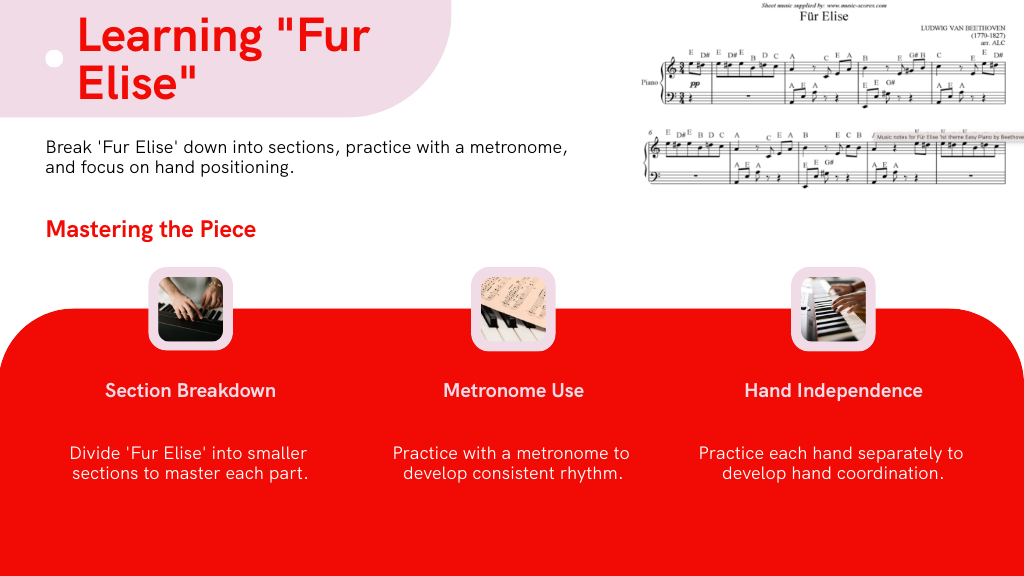
To quickly master “Fur Elise,” you should focus on essential practice techniques and simplify complex sections. Start by breaking the piece into smaller, more manageable parts, allowing you to concentrate on mastering one section at a time. Using a metronome and slowing down tricky passages will help guarantee you’re not only playing correctly but also building muscle memory efficiently.
Essential Practice Techniques
Often, mastering a piece like “Fur Elise” can seem intimidating for beginners. However, breaking down the learning process into specific, manageable steps can make it achievable and even enjoyable.
Here’s how you can approach learning this iconic piece effectively:
- Section Breakdown: Start by dividing “Fur Elise” into smaller, manageable sections. Focus on mastering each part individually before moving on to the next. This strategy helps in achieving smoother shifts when you combine them.
- Metronome Use: Practice with a metronome at a slow tempo. This will help you maintain a consistent rhythm. Gradually increase the speed as your comfort with the notes and rhythms grows.
- Hand Positioning: Pay close attention to your finger positioning and make sure you’re developing hand independence. Your right-hand should carry the melody clearly while your left maintains a steady accompaniment.
- Separate Hands Practice: Begin by practicing hands separately. Master the right-hand melody first, then integrate the left hand to form a cohesive sound.
- Recording Sessions: Record your practice sessions. Listening back can reveal areas that need more focus and show your progress over time.
Simplifying Complex Sections
Mastering “Fur Elise” quickly involves breaking down its complex sections into simpler parts. Start by tackling the right-hand melody since it’s more prominent and easier to grasp. This approach lets you get comfortable with the piece’s main theme without overwhelming yourself with both hands at once.
Next, incorporate the use of a metronome. Set it to a slow pace initially, making sure you nail the timing and rhythm. As you become more confident, gradually increase the speed until you can play at the original tempo. This method guarantees that your performance remains both accurate and expressive.
For the left hand, begin with basic root notes or simplified chords. This strategy reduces the complexity and helps you focus more on mastering the melody with your right hand. Once you’re comfortable, slowly integrate more complex left-hand parts, enhancing the harmony without sacrificing the quality of your learning.
Lastly, don’t shy away from using resources like online tutorials and simplified sheet music. These tools offer step-by-step visual aids and guidance, making the learning process much more manageable and less intimidating. Embrace these aids to help you smoothly navigate through “Fur Elise’s” sections, assuring a successful and enjoyable learning experience.
Mastering “Lean on Me”
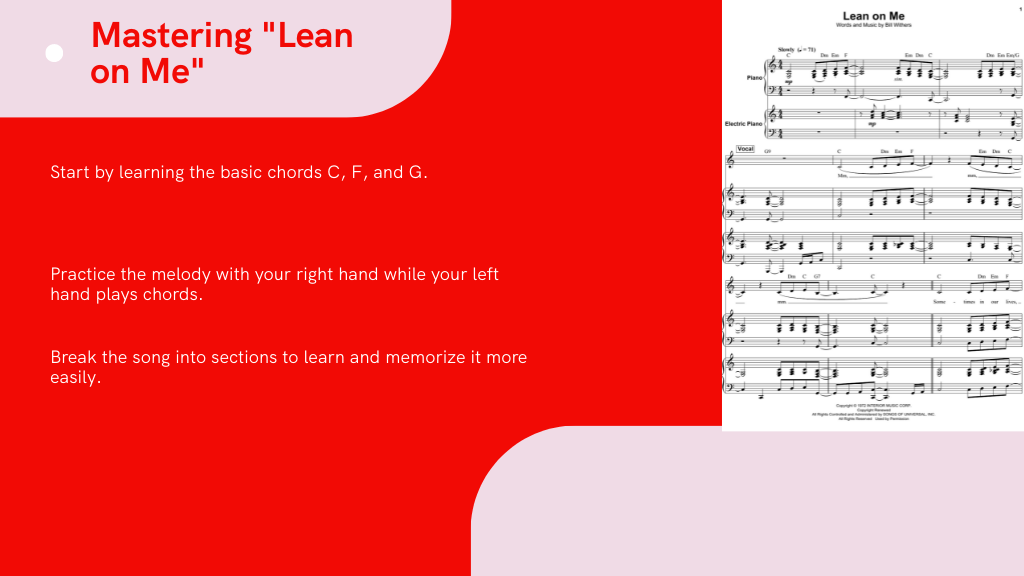
If you’re just starting your piano journey, tackling “Lean on Me” by Bill Withers is an excellent choice. This soulful tune isn’t only popular but also beginner-friendly, thanks to its simple structure and easy-to-learn chords.
Here’s how you can master this song quickly:
- Start with Chords: Focus on learning the three main chords used throughout the song: C, F, and G. These are fundamental chords in the key of C major and will be a great addition to your growing repertoire.
- Hand Coordination: Practice playing the melody with your right hand while your left hand supports with chords. This helps in developing hand independence, vital for playing more complex pieces later.
- Break It Down: Divide the song into smaller sections and master each part before moving on to the next. This method enhances your ability to memorize and retain the song structure.
- Use a Metronome: Incorporate a metronome in your practice sessions to keep your timing consistent. It’s essential for maintaining the flow and rhythm of the song.
- Emotional Expression: Once you’re comfortable with the mechanics, focus on the emotional delivery. “Lean on Me” is a song that resonates with many, so conveying its message effectively will enhance your performance.
Tips for “Twinkle Twinkle”
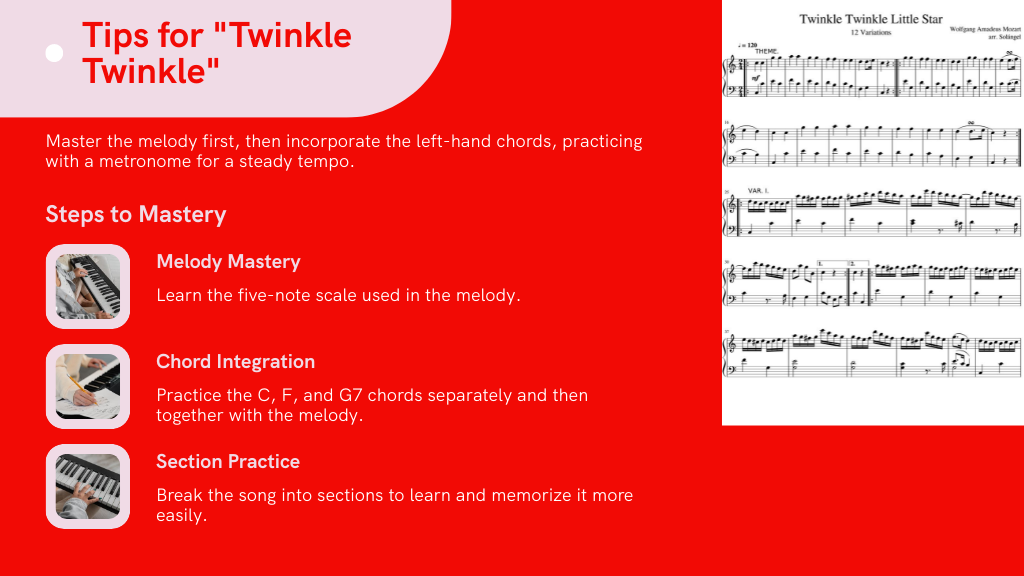
After mastering “Lean on Me,” you’ll find “Twinkle Twinkle Little Star” to be another rewarding piece to add to your repertoire. This classic song isn’t just for children; it’s a fantastic way for you to practice and showcase your growing piano skills.
Start by getting comfortable with the melody. It uses a simple five-note scale: C, C, G, G, A, A, G. Play these notes repeatedly until you can do so from memory.
Next, you’ll want to incorporate the left-hand chords. In C major, you mainly use C, F, and G7. Practice these chords separately, then slowly blend them with the melody. It’s all about coordination—don’t rush this step. Break the song into sections, mastering one phrase at a time. This method helps build your confidence and guarantees you don’t get overwhelmed.
Lastly, use a metronome. It might seem tedious, but it’s essential for developing a steady tempo. Start slow and gradually increase the speed as you become more comfortable. This disciplined approach will make sure your performance of “Twinkle Twinkle Little Star” sounds smooth and polished.
Playing “Happy Birthday” Flawlessly
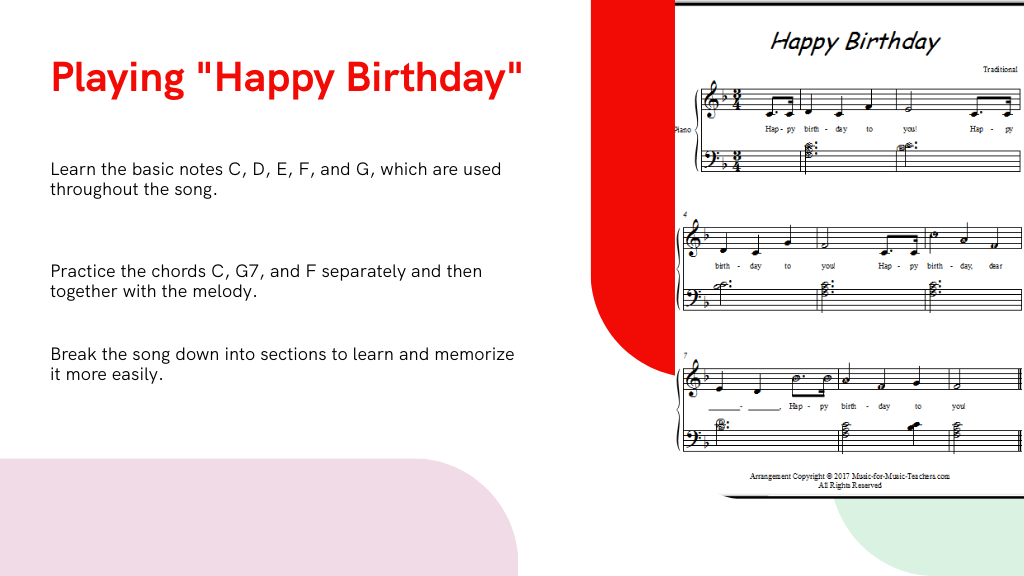
When it comes time to celebrate a loved one’s birthday, being able to play “Happy Birthday” flawlessly on the piano adds a personal touch to the festivities. This iconic tune is perfect for beginning pianists due to its simplicity and the joy it brings to any birthday celebration.
Here are some practical tips to master “Happy Birthday” quickly:
- Start in C Major: Familiarize yourself with the C, D, E, F, and G notes. These are the primary notes used throughout the song, making it easier for you to navigate the keyboard.
- Learn the Chords: The song uses straightforward chords—C, G7, and F. Practice these chords separately before trying to integrate them into the song.
- Memorize the Structure: “Happy Birthday” has a repetitive pattern. Break the song down into small sections and learn each part thoroughly.
- Practice Slowly: Begin by playing the song slowly to guarantee you hit the right notes and chords. Gradually increase your speed as you become more confident.
- Regular Practice: Consistency is key. Regular practice helps solidify your memory and improve your performance.
“Clair De Lune” for Beginners

Now that you’ve mastered “Happy Birthday,” consider adding “Clair de Lune” by Claude Debussy to your repertoire. This piece isn’t only beautiful but also accessible for beginners like you, focusing on essential skills such as expressive dynamics and phrasing. It’s typically arranged in 3/4 time, allowing you to practice the waltz-like rhythms that are both charming and instructive.
You’ll find simplified versions of “Clair de Lune” that retain the enchanting melody while presenting basic chord progressions. These versions are perfect for you to focus on coordinating your hands without the stress of complex arrangements. As you explore this piece, you’ll enhance your ability to play legato, ensuring smooth shifts between notes to produce a flowing, seamless sound.
Moreover, practicing “Clair de Lune” will boost your emotional expression. Its lyrical qualities encourage you to connect personally with the music, interpreting it in a way that reflects your feelings and sensibilities. This connection not only improves your technical skills but also deepens your overall musical experience, making each performance uniquely yours.
Navigating Sheet Music Sources
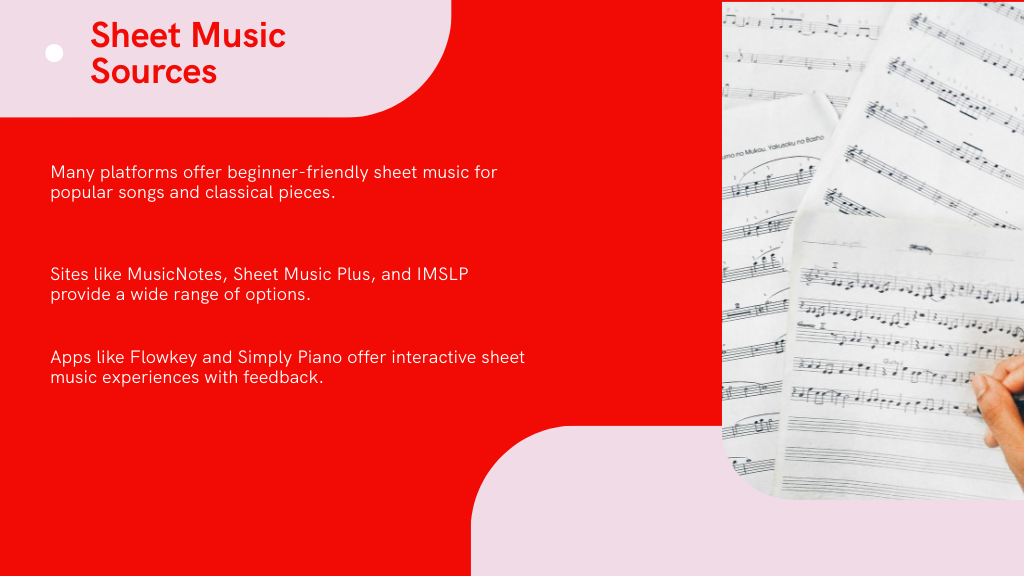
Exploring the right sources for sheet music can dramatically enhance your piano learning journey. As a beginner, you’ll want to access sources that not only provide a wide range of songs but also support your learning curve with easy-to-follow formats and helpful tools.
Here are some top sources you can rely on for high-quality, beginner-friendly sheet music:
- MusicNotes and Sheet Music Plus: These platforms offer a plethora of options tailored for various skill levels, including simplified arrangements of popular songs.
- IMSLP: Immerse yourself in a massive library of public domain classical music ideal for beginners looking to broaden their repertoire without any cost.
- MuseScore: This community-driven website features user-generated sheet music, including numerous beginner-friendly pieces.
- YouTube: Many channels combine video tutorials with sheet music downloads, perfect for visual learners who benefit from watching and playing along.
- Flowkey and Simply Piano: These apps provide interactive sheet music experiences, giving you instant feedback as you play, which is essential for improving your skills effectively.
Leveraging these resources, you’ll find yourself advancing quicker and enjoying each step of your piano-playing journey.
Practice Techniques That Work
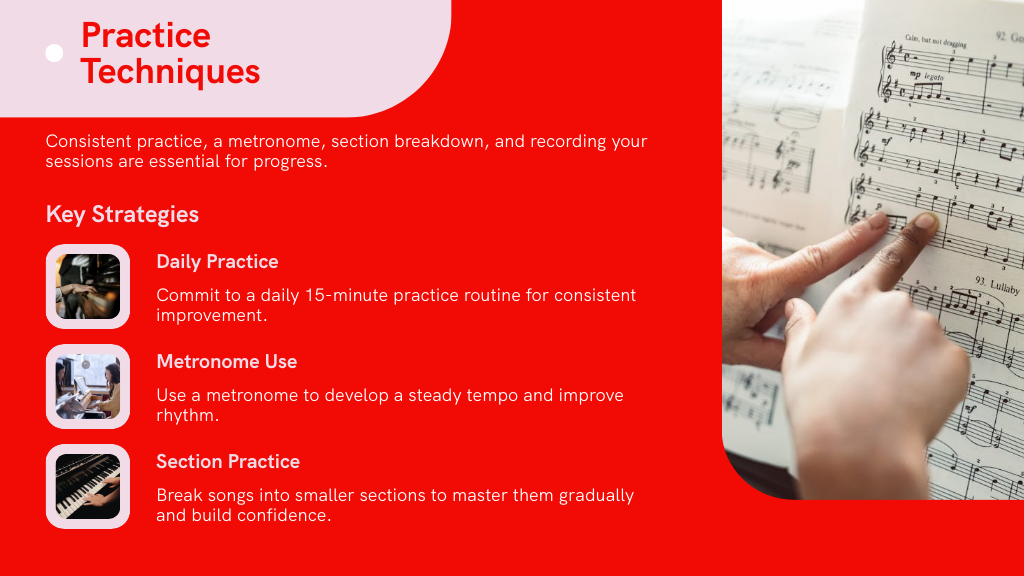
Effective practice techniques are vital for any beginner enthusiastic to master the piano. To get the most out of your practice sessions, sticking to a daily 15-minute routine can be incredibly beneficial. It’s long enough to make progress yet short enough to keep you from feeling overwhelmed.
Integrating a metronome into your practice is also essential. It will help you develop a consistent sense of timing and rhythm, which are foundational for playing any piece of music effectively. Start slow, and gradually increase the speed as you become more comfortable with the notes and rhythms.
Don’t hesitate to break songs into smaller, manageable sections. This allows you to concentrate on mastering one part at a time, which can be particularly helpful for tackling those trickier sections that might otherwise discourage you.
Additionally, recording your practice sessions can provide invaluable insights. You’ll be able to hear your progress and pinpoint specific areas that need improvement. Plus, focusing primarily on the challenging parts during your practice guarantees that you’re continuously pushing your skills forward.
Progressing Beyond Basic Songs

Once you’ve mastered a few simple tunes, it’s time to step up your piano game by tackling more complex songs. Moving forward, you’ll find that the challenge not only keeps you engaged but also sharpens your skills considerably.
Here’s how you can effectively progress:
- Introduce Complex Chords: Start incorporating more complex chord progressions like the I-IV-V or ii-V-I. These are essential in many intermediate pieces and will deepen your understanding of musical structure.
- Coordination Exercises: Focus on exercises that enhance coordination between your right and left hands. This independence is critical for more sophisticated pieces.
- Explore Different Genres: Diversifying the styles of music you play exposes you to different techniques and keeps your practice sessions interesting and educational.
- Set Learning Goals: Aim to master a new song every two weeks. This regular goal-setting helps maintain your motivation and gives you clear milestones to achieve.
- Utilize Online Resources: Leverage tutorials and online lessons. They’re great for learning new songs and techniques that bridge the gap between beginner and intermediate levels.
Frequently Asked Questions
What Is the Easiest Song to Play on the Piano for Beginners?
You’re asking about the easiest piano song for beginners. “Chopsticks” is widely recommended due to its simple, repetitive pattern, making it perfect for you to start with and quickly feel successful.
What Is the Fastest Song to Play on Piano?
You’re wondering what the fastest song to play on the piano is? “Chopsticks” is particularly quick to learn, often mastered in just a few minutes. Its repetitive pattern makes it ideal for beginners.
What Should a Beginner Piano Player Learn First?
You should start by mastering basic piano chords like C, G, and F. Learning these fundamental chords will help you play simple songs and strengthen your understanding of music theory.
What Is an Easy but Impressive Piano Piece?
You’ll find “Let It Be” by The Beatles both easy and impressive. It features simple chord progressions that you can quickly master, making it perfect for showcasing your emerging piano skills.
Conclusion
Now that you’ve got the basics down, keep pushing yourself with these beginner-friendly piano songs. Remember, practice makes perfect. Don’t rush; take your time to enjoy each note and improve at your own pace. You’ll soon find yourself playing more complex pieces with ease. Keep exploring new songs and techniques, and most importantly, have fun on your musical journey. You’re well on your way to becoming a fantastic pianist!


